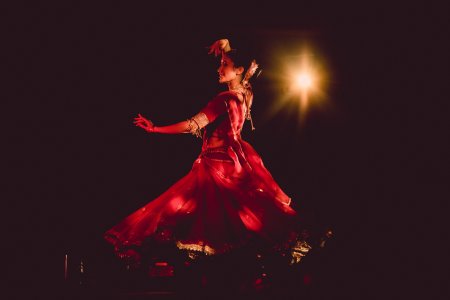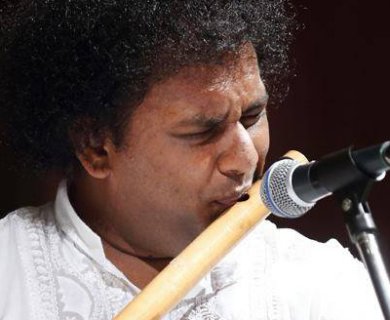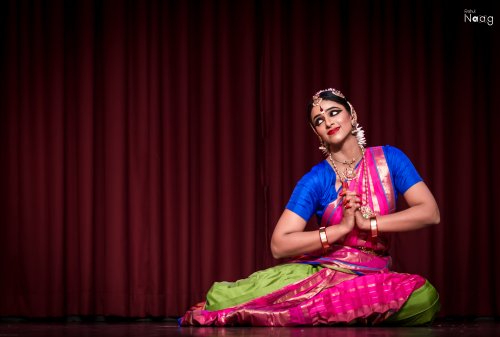
|   |

|   |
|
When Krishna is born - Madhur Gupta e-mail: madhurgupta04@gmail.com August 28, 2019 An important festival in the Vaishnavism tradition, Janmashtami fell last week as observed according to the Hindu luni-solar calendar, on the eighth day (Ashtami) of the Krishna Paksha (dark fortnight) in Shraavana of the lunar Hindu calendar and Krishna Paksha in Bhadrapad of the luni-solar Hindu calendar. When the entire world was drenched in the Krishnamaya bhakti celebrating the arrival of the Lord of the Universe, how could the performing arts remain aloof from drowning in the colors of Krishna.  Shivani Verma (Photo: ANX media and Anchal Seth) At Guild of Service, one witnessed graceful Kathak by Shivani Verma presenting the two women Devaki and Draupadi, in whose lives Krishna featured as Bal Gopal and the savior Virat Rupa and changed their lives forever. Shivani's act opened with Devaki, "The earth resounded with the auspicious sounds of conches, clarinets, clay tomtoms and kettledrums as Kansa drove the chariot carrying his cousin sister Devaki and her bridegroom Vasudev, when Mahamaya's voice pierced through the sky and brought an irrevocable change in Devaki's life." The newly married couple, thrown into the prison, welcomed their first child, Kirtimaan. 'Aho Pati so upaay kachhu keeje...' Devaki pleaded with Vasudeva to use any means to protect their baby but Vasudeva, true to his promise, took the newborn to his uncle. Kansa's heart melted at the sight of his nephew and initially, he spared Kirtimaan. However, Narada Muni tricking Kansa through the metaphor of a lotus confused him with who can be counted as the first and who as the eighth. On Narada Muni's instigation, Kansa retracted and killed the infant. The renowned storyline continued with Devaki helplessly watching six of her children murdered. In the month of Bhadon, when she was expecting Shri Hari, she was incandescent as an enclosed flame; the fetters that they had been tied with fell away. Full of joy, the earth danced and the heavens with it, as apsaras danced and the gods sang, welcoming the savior of the Universe. Shivani aptly chose "Bhaadon ki rain andhiyaari..." to depict Devaki who was ever fearful of the fate of her divine child. With a heavy heart she sent him away with Vasudeva and ruminated that even if she will be deprived of the joy of witnessing his childhood, she will continue to live hearing the tales of his leelas in Vrindavan; "naahin na itno bhaag jo yeh ras, nit lochan put peejay. Surdas aise sut ko jas, shravanani suni suni jeejay..." Transmitting from vatsalya rasa to Sakha bhava, beautifully clad and delicate as a flower in her technique, Shivani Verma moved on to the representation of fire born Yajnaseni who the world came to know as Draupadi. In her hour of greatest need, Sri Krishna was the only being who helped her through crisis, the most shameful and significant one being her disrobing or the 'cheer haran' in the Kaurav Sabha. The dancer with much prowess depicted this tale of an immortal story of true friendship.  Rajat Prasanna Next one heard the mellifluous Rajat Prasanna, playing the beloved bansuri of the Lord in a concert titled Aarambh-XV presented by the Raza Foundation. Tracing his lineage in the Benaras Gharana to his grandfather, late Pandit Raghunath Prasanna, who was the guru of the celebrated flutist Hariprasad Chaurasia, Rajat opened his recital with raga Puriya Dhanashree. Very close to raag Purvi, which employs both madhyams, this particular raga evokes deep compassion and is emotionally charging in character. Rajat chose to present a bandish in teentaal starting with the alapchari. The vadi swara being pancham and the samavadi rishabh, brought out an intense meditative quality of the raga. Staying true to his lineage, Rajat also chose to enthrall the audience with a rendition of a Banarasi dhun in raga Mishra Khamaj, extolling the rustic and playfully rural flavors of the city of Mokshya.  Radhika Kathal (Photo: Rahul Naag) Radhika Kathal, a senior disciple of Bharatanatyam Guru Geeta Chandran also chose to delve into the leelas of Lord Padmanabhaswamy. Her recital began with an Alarippu followed by a shlokam dedicated to Tripura Sundari, a composition of Adi Shankaracharya, describing the various facets of the Devi. Accurately opening with this Khanda Jati alarippu, Radhika stayed true to the literal meaning of the piece: blossoming of the lotus. Just as the lotus unfolds its beautiful petals in presence of the sun, the dancer unfolded her body and began with the movement of the eyes, neck and slowly the entire body in complex rhythmic patterns. Instead of choosing a Pada Varnam which is more commonly used for dance recitals, the dancer chose a Sringara Tana Varnam in ragam Karnataka Kaapi, showcasing the libretto by Maharaja Swathi Tirunal in rupaka talam, evoking Lord Padmanabhaswamy. Deftly amalgamating the rivulets of bhava, raga, and tala, the dancer charted the much explored seas of the sakhi conveying to the Lord, her friend's tormented state and coaxing him to go meet her. In this lovelorn plight the sahityam described how sakhi's friend is tormented by the arrows of Kamadeva, and that she would die lest her Lord come sees her, this very minute! In the charanam, the sakhi pleaded with Lord Padmanabha to have pity on her friend and end her plight, bringing down curtains to this celebration of the birth of Lord Krishna. Aarambh took place on August 21, 2019 at Triveni Kala Sangam, New Delhi. Odissi dancer Madhur Gupta is a disciple of Guru Sharon Lowen. He contributes to national dailies like The Hindu, The Times of India, The Asian Age, The Indian Express covering at large the Indian classical dance and music scene of the subcontinent. |